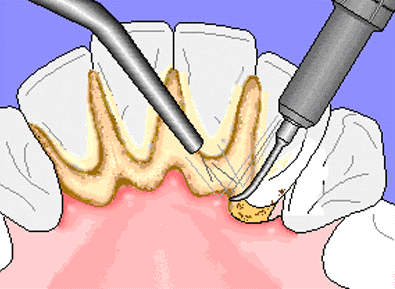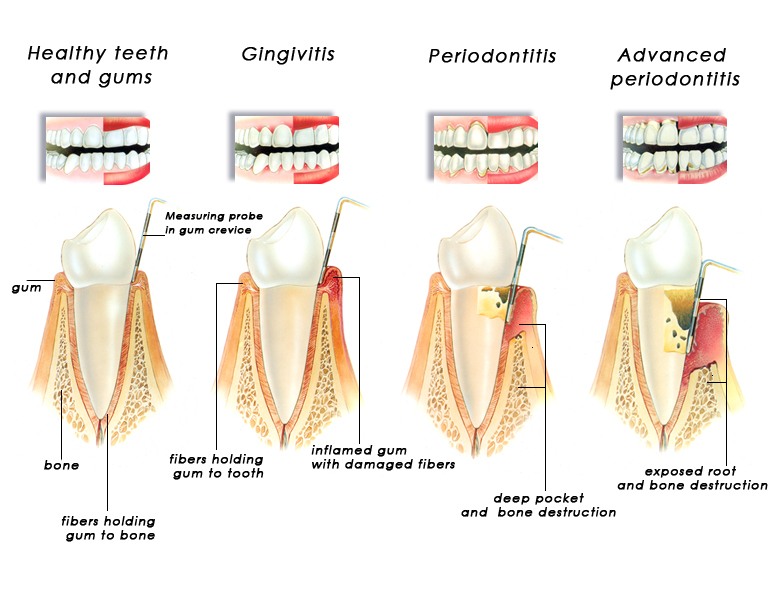Dental Cleaning/Scaling and Polishing
Worried about bad breath? Bad breath can get in the way of your social life. It can make you self-conscious and embarrassed. Fortunately, there are simple and effective ways to freshen your breath.
When is a scale and polish necessary?
Despite our best efforts, brushing twice a day does not remove all the plaque in our mouths, plaque that remains in the mouth will eventually harden and form calculus or tartar. Manual tooth brushing will not be able to remove this tartar and it must be removed by the dentist only.
How is this done?

This is done by the dentist with a high frequency vibration scaler that ultrasonically removes the tartar from the tooth surface. This can also be done by hand, for those with very sensitive teeth and gums. The teeth are given a polish with an abrasive paste to make them smooth and to prevent plaque from adhering to the teeth.
What happens if I do not get a regular cleaning done?
The results of not having regular cleanings done will not be immediately apparent, but if tartar is left on the teeth, it thickens over time, becomes a bacteria trap and starts causing gum disease.
What Causes Gum Disease?
Plaque is the primary cause of gum disease. However, other factors can contribute to periodontal disease. These include:
- Hormonal changes, such as those occurring during pregnancy, puberty, menopause, and monthly menstruation, make gums more sensitive, which makes it easier for gingivitis to develop.
- Illnesses may affect the condition of your gums. This includes diseases such as cancer or HIV that interfere with the immune system. Because diabetes affects the body's ability to use blood sugar, patients with this disease are at higher risk of developing infections, including periodontal disease and cavities.
- Medications can affect oral health, because some lessen the flow of saliva, which has a protective effect on teeth and gums. Some drugs, such as the anticonvulsant medication Dilantin and the anti-angina drug Procardia and Adalat, can cause abnormal growth of gum tissue.
- Bad habits such as smoking make it harder for gum tissue to repair itself.
- Poor oral hygiene habits such as not brushing and flossing on a daily basis, make it easier for gingivitis to develop.
- Family history of dental disease can be a contributing factor for the development of gingivitis.
Gum disease symptoms includes:
- Sore and bleeding gums
- Bad breath
- Metallic taste in mouth
- General sore mouth
- Inflamed gums
- Loose or mobile teeth.
As gum disease progresses, it starts affecting the tissue holding the teeth in the jaw and progresses to periodontitis. The gums become red and inflamed, may bleed while brushing or even spontaneously, the gum begins to ‘shrink’ or recede and teeth may become mobile due to loss in bone height.
How is gum treatment different from scale and polish?
A scale and polish is a simple procedure that is usually done in one appointment and involves the removal of superficial tartar build-up around the teeth and gums. The tartar build-up at this stage has not caused much damage to gums and bone.
With gum treatment, inflammation of the gums will mean that the treatment will need to be done over several appointments. Depending on your level of discomfort, you may or may not need an anaesthetic for the procedure. Sometimes, with cases of very severe gum disease or very heavy tartar build-up, the dentist may decide to clean one half of your mouth per visit.
Gum treatment involves clearing plaque and tartar from the deep tissue pockets to help the gums regenerate.
What can be expected after a scale and polish or gum treatment?
Initially, your gums may feel sensitive, and your teeth may feel "empty". Sensitivity is normal and the sensitivity should subside after a few days, using a fluoridated tooth paste will help with this. The empty feeling will pass as well, and this sensation is usually the result after the tartar between the teeth is removed.
How can I avoid gum disease?

- Ways to prevent gum disease include
- 1. Brush twice a day
- 2. Floss regularly
- 3. Mouthwash should be used half an hour after brushing
- 4. Visit your dentist regularly and have a regular scale and polish
- 5. Avoid smoking
- 6. Eat a balanced diet
Treatment of Gum Disease
There are a variety of treatments for gum disease depending on the stage of disease, how you may have responded to earlier treatments, and your overall health.Treatments range from nonsurgical therapies that control bacterial growth to surgery to restore supportive tissues.
Treatments for gum disease that don't involve surgery include:
Professional dental cleaning. During a typical appointment we will remove the plaque and tartar (plaque that builds up and hardens on the tooth surface and can only be removed with professional cleaning) from above and below the gum line of all teeth. If you have some signs of gum disease, we may recommend professional dental cleaning more than twice-a-year.
What is root planing and deep curettage?
Scaling and root planing. This is a deep cleaning, nonsurgical procedure, done under a local anesthetic, whereby plaque and tartar from above and below the gum line are scraped away (scaling) and rough spots on the tooth root are made smooth (planing). Smoothing the rough spots removes bacteria and provides a clean surface for the gums to reattach to the teeth. Scaling and root planing is done if you have plaque and calculus (hardened plaque, also called tartar) under the gums that needs to be removed.
Gum Surgery (Surgical Treatments for Gum Disease)
What is Flap surgery
During this procedure the gums are lifted back and the tarter is removed. In some cases, irregular surfaces of the damaged bone are smoothed to limit areas where disease-causing bacteria can hide. The gums are then placed so that the tissue fits snugly around the tooth. This method reduces the size of the space between the gum and tooth, thereby decreasing the areas where harmful bacteria can grow and decreasing the chance of serious health problems associated with periodontal disease.
What are Bone grafts.
This procedure involves using fragments of your own bone, synthetic bone, or donated bone to replace bone destroyed by gum disease. The grafts serve as a platform for the regrowth of bone, which restores stability to teeth. New technology, called tissue engineering, encourages your own body to regenerate bone and tissue at an accelerated rate.
What are Soft tissue grafts.
This procedure reinforces thin gums or fills in places where gums have receded. Grafted tissue, most often taken from the roof of the mouth, is stitched in place, adding tissue to the affected area.
What is Guided tissue regeneration.
Performed when the bone supporting your teeth has been destroyed, this procedure stimulates bone and gum tissue growth. Done in combination with flap surgery, a small piece of mesh-like fabric is inserted between the bone and gum tissue. This keeps the gum tissue from growing into the area where the bone should be, allowing the bone and connective tissue to regrow to better support the teeth.
What is Bone surgery?
This procedure smoothes shallow craters in the bone due to moderate and advanced bone loss. Following flap surgery, the bone around the tooth is reshaped to decrease the craters. This makes it harder for bacteria to collect and grow.
In some patients, the nonsurgical procedure of scaling and root planing is all that is needed to treat gum diseases. Surgery is needed when the tissue around the teeth is unhealthy and cannot be repaired with nonsurgical options.
What's the Difference Between Gingivitis and Periodontitis?
Gingivitis (gum inflammation) usually precedes periodontitis (gum disease). However, it is important to know that not all gingivitis progresses to periodontitis.
In the early stage of gingivitis, bacteria in plaque build up, causing the gums to become inflamed and to easily bleed during tooth brushing. Although the gums may be irritated, the teeth are still firmly planted in their sockets. No irreversible bone or other tissue damage has occurred at this stage.
When gingivitis is left untreated, it can advance to periodontitis. In a person with periodontitis, the inner layer of the gum and bone pull away from the teeth and form pockets. These small spaces between teeth and gums collect debris and can become infected. The body's immune system fights the bacteria as the plaque spreads and grows below the gum line.
Toxins or poisons -- produced by the bacteria in plaque as well as the body's "good" enzymes involved in fighting infections -- start to break down the bone and connective tissue that hold teeth in place. As the disease progresses, the pockets deepen and more gum tissue and bone are destroyed. When this happens, teeth are no longer anchored in place, they become loose, and tooth loss occurs. Gum disease is the leading cause of tooth loss in adults.
What are receding gums
Gum recession is the process in which the margin of the gum tissue that surrounds the teeth wears away, or pulls back, exposing more of the tooth, or the tooth's root. Receding gums may be one of the first signs of gum disease. When gum recession occurs, "pockets," or gaps, form between the teeth and gum line, making it easy for disease-causing bacteria to build up. If left untreated, the supporting tissue and bone structures of the teeth can be severely damaged, and may ultimately result in tooth loss.
Gum recession is a common dental problem. Most people don't know they have gum recession because it occurs gradually. The first sign of gum recession is usually tooth sensitivity, or you may notice a tooth looks longer than normal. Often a notch can be felt near the gum line.
Why Do Gums Recede?
There are a number of factors that can cause your gums to recede, including:
- Periodontal diseases
- Your genes
- Aggressive tooth brushing
- Insufficient dental care
- Hormonal changes
- Tobacco products
- Grinding and clenching your teeth
- Crooked teeth or a misaligned bite
These are bacterial gum infections that destroy gum tissue and supporting bone that hold your teeth in place. Gum disease is the main cause of gum recession.
Some people may be more susceptible to gum disease. In fact, studies show that 30% of the population may be predisposed to gum disease, regardless of how well they care for their teeth.
If you brush your teeth too hard or the wrong way, it can cause the enamel on your teeth to wear away and your gums to recede.
Inadequate brushing and flossing makes it easy for plaque to turn into calculus (tartar) -- a hard substance that can only be removed by a professional dental cleaning -- and build up on and in between your teeth, causing gum recession.
Fluctuations in female hormone levels during a woman's lifetime, such as in puberty, pregnancy, and menopause, can make gums more sensitive and more vulnerable to gum recession.
Tobacco users are more likely to have sticky plaque on their teeth that is difficult to remove, which can cause gum recession.
Clenching or grinding your teeth can put too much force on the teeth, causing gums to recede
When teeth do not come together evenly, too much force can be placed on the gums and bone, allowing gums to recede.
How is Gum recession treated
Mild gum recession may be treated by deep cleaning(scaling and root planing) the affected area.
If your gum recession cannot be treated with deep cleaning because of the excess loss of bone and pockets that are too deep, gum surgery may be required to repair the damage caused by gum recession.